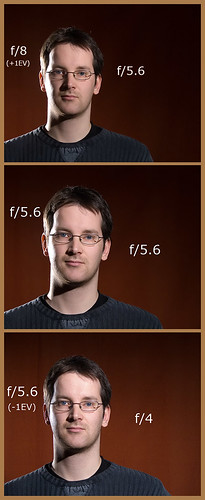 Reader Till Hamburg asks the above question in the Strobist Flickr Pool, and posts a series of photos just to prove his point. First of all, a little explanation of what Till means by these numbers. Then, an explanation and how to make that angle-dependent strength thing work for you.
Reader Till Hamburg asks the above question in the Strobist Flickr Pool, and posts a series of photos just to prove his point. First of all, a little explanation of what Till means by these numbers. Then, an explanation and how to make that angle-dependent strength thing work for you.The series of photos at left have two lights which concern us. (Looks like there is a backgrond light going on there, too. But let's ignore that for the purposes of this discussion.)
In the top photo, the rim light is set one stop hotter than the light at camera right (which is illuminating the subject's face.) In the middle, they are equal. And in the bottom, the rim light is one stop lower than the main light.
__________
PLEASE NOTE: I think he has his f/stops reversed in the label on the bottom photo. As you can see, the main light is remaining constant, while the rim light drops a stop each frame, heading toward the bottom.
__________
This lighting quirk used to screw me up all of the time when I would shoot a rim-lit situation, until I figured out what was going on.
Why it happens, and a way to make this work for you, after the jump.
____________________________
Rimshot, Please...
The first component of the higher efficiency of rim light is the physical property of the way anything reflects when it hits something at a shallow angle. I always use the analogy of light behaving like a pool ball when it comes to reflections, as in this post on how to light people wearing glasses.
So let's stretch the light-as-pool-ball analogy a little more and think in terms of retained energy. A glancing reflection off of something will use up less energy than a direct hit. So to will light glancing off of a 3-d object. It is simply a more efficient way to reflect.
Second, rim lights are more likely (than main lights) to be hard light sources. As we have learned, hard light sources create stronger specular reflections than do larger light sources. I know the specular reflection strength is a component to rim lighting being more efficient because I see the effect lessened when my rim light is soft.
So, how can you use this info?
Well, you certainly want to use your weakest light as a rim light to take advantage of the efficient rim light thing. In fact , when I am rim lighting in close, I usually start my SB-800s at 1/128 power and adjust my working aperture to where that looks good as a starting point.
As you can see above, even one stop down is a little hot for a rim light. I tend to start out at two stops down. (If you work without a flash meter, as I do, use your guide number chart to get you close on the first pop.
Also, if a room is ambient-lit in a poor, muddy-ish, ASA-800 kinda way and you only have one light, consider using that light as a separation/rim light (instead of in front) to add depth to your scene. Because of the efficiency of the lighting angle, you can back that speedlight way back (adding depth and internal separation and slow fall-off to the whole scene) even though your speedlight is not very powerful.
___________________
Related posts:
:: L101: Lighting People With Glasses ::
:: L102: Specular Highlights ::
:: Guide Numbers: Your Free Flash Meter ::




0 comments:
Post a Comment